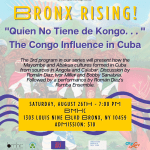Recommended resource: Ivor Miller’s Youtube channel
At the root of Cuban music is the culture Africans created to adapt, survive and thrive in the brutal circumstances they found themselves in the New World.
One of these Afro-Cuban spiritual systems is Abakuá.
Like everything African and Afro-Cuban, it’s not just music, it’s not just dance, it’s not just a religious service.
This event was filmed in 2008 on Epiphany which is twelve days after Christmas and marks the start of Carnival season. Traditionally, it’s the day the Three Kings paid a visit on newborn Jesus.
On this day, enslaved Africans were permitted to openly celebrate and parade.
Needless to say, their celebration had and has nothing to do with the Christian church.
What is Abakuá?
First, of all it is a living tradition. Though it is sometimes referred to and treated as “folkloric” this designation is a great understatement.
Abakuá is a men’s secret society founded in the port districts of Havana and Matanzas and found nowhere else in the Americas.
It has a direct connection to the Egbo (or Ekpe) leopard society that operated as a form of government in the area now in western Cameroon and southeastern Nigeria.
We went into this history in some detail here previously.
In Cuba, Abakuá has a elaborate and abundant repertoire of stories, songs, costumes, and drums and even its own pictographic writing system and language understood only by initiated members.
Abakuá’s existence was first recorded in 1836 as the importation of kidnapped Africans was accelerating to accommodate the exploding needs of the rapacious sugar industry.
Ivor Miller, who you can learn more about at the link above and appears in the last video below, estimated in the year 2000 that there were 117 Abakuá societies active in Cuba with approximately 20,000 initiated members total.
Militant, defiant, proud and taking no s*** from anybody, in Cuba the Abakuá were about self-preservation via mutual aid and protected their operations and culture with a secrecy that is still impenetrable to outsiders
Not unlike the Sicilian Mafia, the Abakuá controlled one of the roughest places in Cuba (or any country): the docks and as we mentioned in a previous post Cuba’s docks gave birth to rumba.
Quoting New Sublette from “Cuba and Its Music”:
“In those same warehouses worked many rumberos, dancers, drummers, and singers.
Most of the hardest-core rumberos of Matanazas, Havana, and Cádenas were and are Abakuá…
Abakuá-themed material has always been part of the repertoire of rumba. Certain Abakuá dance moves show up in rumba dancing, like the shimmy the male dancer does, reminiscent of the diablito shaking his hips to rattle his string of bells.”
Here’s a short film of an Abakuá performance staged for documentation made in 1962 by Bernabé Hernández and presented by El Instituto Cubano del Arte e Industria Cinematografico.
Here’s a short video made in Havana in 2016 documenting an Abakuá event hosted by Reinaldo Brito del Valle of the Uriabón Efí lodge of Havana.
Brito, born in 1930, is the composer of many rumbas, including “El Niño Rey” and “Protesta Carabalí”. The video was directed by Mayckell Pedrero and includes an appearance by the scholar Ivor Miller.
Recommended resource: Ivor Miller’s Youtube channel
– Ken McCarthy
Jazz on the Tube
P.S. Our unique programming is made possible by help from people like you. Learn how you can contribute to our efforts here: Support Jazz on the Tube
Thanks.






